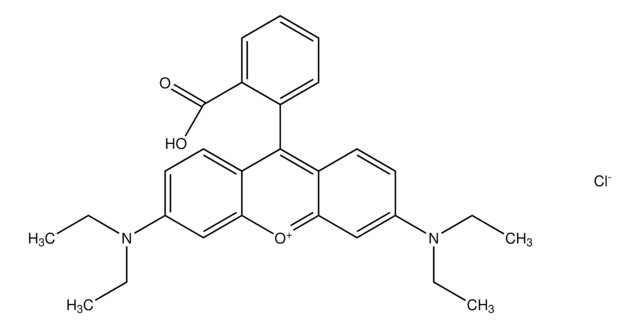02558
Rhodamine B solution
0.2% in isopropanol, for TLC derivatization
About This Item
Produits recommandés
Qualité
for TLC derivatization
Niveau de qualité
Concentration
0.2% in isopropanol
Technique(s)
thin layer chromatography (TLC): suitable
Densité
0.79 g/mL at 20 °C
Chaîne SMILES
[Cl-].CCN(CC)c1ccc2c(OC3=CC(\C=CC3=C2c4ccccc4C(O)=O)=[N+](\CC)CC)c1
InChI
1S/C28H30N2O3.ClH/c1-5-29(6-2)19-13-15-23-25(17-19)33-26-18-20(30(7-3)8-4)14-16-24(26)27(23)21-11-9-10-12-22(21)28(31)32;/h9-18H,5-8H2,1-4H3;1H
Clé InChI
PYWVYCXTNDRMGF-UHFFFAOYSA-N
Application
Mention d'avertissement
Danger
Mentions de danger
Conseils de prudence
Classification des risques
Eye Irrit. 2 - Flam. Liq. 2 - STOT SE 3
Organes cibles
Central nervous system
Code de la classe de stockage
3 - Flammable liquids
Classe de danger pour l'eau (WGK)
WGK 2
Point d'éclair (°F)
53.6 °F - closed cup
Point d'éclair (°C)
12 °C - closed cup
Équipement de protection individuelle
Eyeshields, Faceshields, Gloves, type ABEK (EN14387) respirator filter
Choose from one of the most recent versions:
Déjà en possession de ce produit ?
Retrouvez la documentation relative aux produits que vous avez récemment achetés dans la Bibliothèque de documents.
Les clients ont également consulté
Notre équipe de scientifiques dispose d'une expérience dans tous les secteurs de la recherche, notamment en sciences de la vie, science des matériaux, synthèse chimique, chromatographie, analyse et dans de nombreux autres domaines..
Contacter notre Service technique












